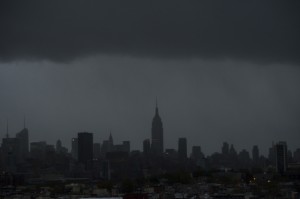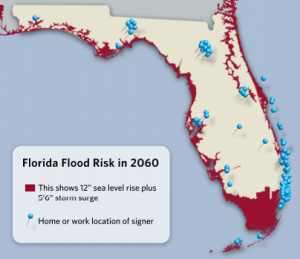
The Empire State Building and large portions of midtown Manhattan are seen without power as a result of Hurricane Sandy on Tuesday, Oct. 30, 2012 in New York. (AP Photo/Charles Sykes)
Though New York wasn’t prepared for the severity of the surge we saw on Monday, rising sea levels associated with climate change have been on the city’s radar for some time.
In 2007, Mayor Michael Bloomberg released PlaNYC, an over-200-page proposal for how to make New York more sustainable. “Our extensive physical infrastructure — including more than 700 miles of subways, 90,000 miles of underground power cables, 14 wastewater treatment plants, and 2,000 bridges and tunnels — is aging. It is often immovable and was built for different environmental conditions than it is likely to face in the future,” the document said of New York City. It included plans for working with the Federal Emergency Management Agency (FEMA) to mitigate rising sea levels and acknowledged that “to create a more resilient city” New York would have to find better ways to protect the nearly 200,000 who live in flood zones.
In August, the City Council made permanent a task force Bloomberg created in 2008 to fulfill the goals outlined in PlaNYC. The August legislation also refocused the task force’s mission on New York’s most vulnerable populations, including those living in poverty and the elderly.
Still, many warn that while the plans look good on paper, the city has been too slow putting them into practice. New York Governor Andrew Cuomo said yesterday that he had planned talks with the city administration to discuss new measures to prevent flooding.

A parking lot full of yellow cabs is flooded as a result of Hurricane Sandy on Tuesday, Oct. 30, 2012 in Hoboken, NJ. (AP Photo/Charles Sykes)
Over the last fifty years, tides have risen by at least half a foot on the Florida coast. When the storm surge from 1992’s Hurricane Andrew caused tides as high as 16 feet above average, Miami changed its approach to storm preparedness.
“As far as storms getting worse, Cat 5 Hurricane Andrew was a game changer here,” said Curtis Sommerhoff, Director of Emergency Management for Miami-Dade County — “ground zero for sea level rise,” according to some descriptions. “Since Hurricane Andrew we have adopted a stringent building code (one of the best on the planet); gone from having an emergency shelter deficit to having a shelter surplus; and have put in excess of $265 million dollars into windstorm and flood mitigation projects.”
In 2007, the United Nation’s Intergovernmental Panel on Climate Change estimated that sea levels would rise between .6 and 1.9 feet by 2099. In 2010, the National Academies’ Board on Atmospheric Sciences and Climate called the IPCC’s levels conservative, citing studies that suggested seas would rise by anywhere from 2 to 6.5 feet during the 21st century.
 On the federal level, FEMA is scaling back funding for its Flood Hazard Mapping and Risk Analysis Program. Between 2011 and 2012, the budget for the program was cut nearly in half. Much of FEMA’s response to climate change has dealt with adapting the National Flood Insurance Program — though next year’s proposed budget would allocate about $1.5 billion more for state and local programs to address regional issues. Under the next president, the agency’s budget would see more cuts — The Washington Post reports that Obama would decrease its budget by 3 percent, and Romney’s proposed cuts to discretionary spending would cut funding for FEMA by about 40 percent.
On the federal level, FEMA is scaling back funding for its Flood Hazard Mapping and Risk Analysis Program. Between 2011 and 2012, the budget for the program was cut nearly in half. Much of FEMA’s response to climate change has dealt with adapting the National Flood Insurance Program — though next year’s proposed budget would allocate about $1.5 billion more for state and local programs to address regional issues. Under the next president, the agency’s budget would see more cuts — The Washington Post reports that Obama would decrease its budget by 3 percent, and Romney’s proposed cuts to discretionary spending would cut funding for FEMA by about 40 percent.
Before the final presidential debate in Boca Raton, Florida, over 120 Florida city officials and scientists sent a letter to the presidential candidates urging them to discuss sea level rise and climate change during the debate. They wrote:
“Florida is already feeling the effects of sea level rise and, increasingly, it jeopardizes the health, safety, and economic well-being of our communities. […] Unfortunately, global sea level rise is a danger that must be considered by the next president of the United States. The issue threatens the future of Florida, the nation, and communities around the world. Providing effective solutions will challenge all levels of government.”
But the candidates did not discuss climate change or rising sea levels in the final debate – just as they didn’t in either of the first two.

